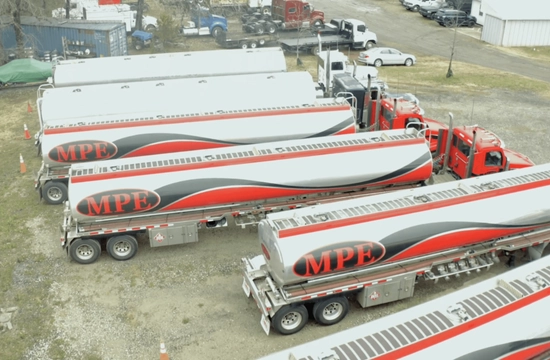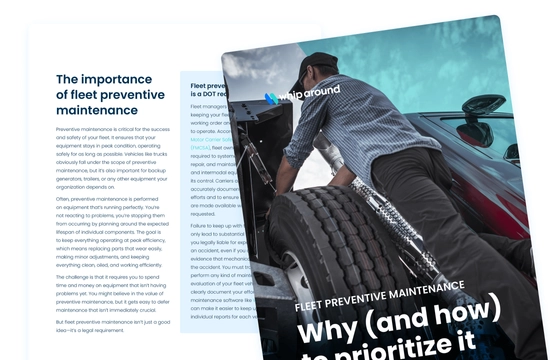- SolutionsMaintenance
Fleet maintenance software for vehicles and equipment
ComplianceEverything you need to keep your fleet compliant with the DOT
InspectionsVehicle inspection software that keeps you compliant and cuts costs
ReportingAccess the vital data you need to optimize the performance of your fleet
Fuel ManagementTrack fuel usage in real time and maximize profitability through fuel cost tracking
IntegrationsSee all - CustomersFeatured Case StudiesSee all
![Spartan Logistics]() Spartan Logistics
Spartan LogisticsSpartan Logistics is a safer, more efficient business by keeping their maintenance up and costs down with Whip Around.
View case study![Monster Tree Service]() Monster Tree Service
Monster Tree ServiceWhip Around gives Monster Tree Service visibility on vehicle & equipment location, condition, what work is due and what has been completed
View case study![Northwest Repossession]() Northwest Repossession
Northwest RepossessionNorthwest Repossession saves tens of thousands of dollars every year by staying totally compliant with Whip Around.
View case study![M. Pittman Enterprises]() M. Pittman Enterprises
M. Pittman EnterprisesThe team at M. Pittman turned to Whip Around for a digital solution to take the guesswork out of their preventive maintenance process.
View case study - ResourcesFeatured ContentSee all
![eBook: Fleet preventive maintenance: Why (and how) to prioritize it]() eBook: Fleet preventive maintenance: Why (and how) to prioritize it
eBook: Fleet preventive maintenance: Why (and how) to prioritize itEverything you need to make preventive maintenance a priority for your fleet.
View eBook![eBook: Creating a preemptive culture of safety, compliance, and preventive maintenance]() eBook: Creating a preemptive culture of safety, compliance, and preventive maintenance
eBook: Creating a preemptive culture of safety, compliance, and preventive maintenanceHow to build a preemptive culture of safety in six steps.
View eBookResource Type - Pricing
How to Improve Fleet Management

Fleet Management Software vs. Paper Based Fleet Management
The use of paper-based fleet management systems creates a budgeting strategy that is behind the ball, so to speak. It takes much longer for data to be obtained, tracked, and interpreted by Fleet Maintenance Managers and the data obtained is not always as reliable or standardized as what fleet management software can provide. This delays data analysis, compromises the integrity of the data, and limits a Fleet Maintenance Manager’s ability to make accurate predictions about future needs and decisions regarding fleet and driver management.
Downtime, the Dominant Fleet Expense
The paper trail is paved with big bills. As compared to fleet maintenance software, paper-based management systems restrict workflow and are arguably the number one contributor to increased vehicle downtime, to the tune of $448 – $760 per day. Studies show that paper-based systems extend vehicle downtime by up to 2.7 days, while the average repair time is only 5.4 hours(!) It’s even worse for external maintenance which prolonged downtime of up to 4.5 days.
Why is this?
It is because submitting written fault reports which then get generated into work orders that are sent to the mechanic where they eventually work their way to the top of the task list takes an exorbitant amount of time. This also leads plenty of room for human error, especially in the realm of concise, clear, comprehensive communication.
Tracking Driver and Vehicle Stats
Without fleet management software, tracking driver and vehicle data is sketchy at best and is subject to the individual driver’s consistency with accurately filling out his/her paperwork. Think of odometer readings, fuel purchases, daily checklists, and fault reporting. And that’s just the driver. Without fleet management software, forget live tracking, real-time engine performance, or avoiding traffic congestion. It does not have to be this way.
Fleet Management Software for Real-Time Maintenance and Streamlined Workflow
There’s a reason we don’t use a horse and buggy, candles, and washboards anymore. Reasons such as speed, effectiveness, and labor. Likewise, transitioning from outdated and cumbersome paper-based management systems to fleet maintenance and management software will also improve speed, effectiveness, and labor. How? There’s no faster speed than “real-time.” Customized forms on easy-to-use fleet management apps for drivers to utilize will increase communication accuracy and repair efficiency. Digital customized work orders submitted instantly to the mechanic and manager decrease the labor by prioritizing the most important assets and repairs.
Take Inventory and Prioritize Action
When Fleet Managers have instant access to fleet and driver data from their dashboard, they are able to see the “big picture” and attend to the biggest, most urgent needs first. User-friendly fleet management apps allow drivers to include photos and comments with repair requests which helps the fleet manager prioritize maintenance and repairs appropriately. Driver’s inspections performed to prevent or report accidents or failures are customizable and easy to use on mobile apps.
Checklists
Daily Vehicle Inspection Reports are not the only itemized reports required for fleet operations. Each fleet will run more smoothly with its own customized paper maintenance checklists. The good news is that however these are currently formatted, they can easily be transferred to the mobile fleet management app. Mobile checklists provide data in real-time and keep the Fleet Maintenance Manager informed.
Analytics
Fleet maintenance and management software with its accompanying mobile-friendly apps provide clarity. With each driver having his/her own profile and assigned vehicle, it is easy to track individual inspection records as well as vehicle data. Each driver has their own login and DVIRs can be viewed by date range. Analytics can include the number of inspections and faults, trends in faults, traffic and mileage, data-based maintenance and budgeting decisions, and the use of vehicle histories to make purchasing decisions.
Take Control
Stay ahead of repairs and reduce costly downtime by utilizing fleet management software. View a vehicle’s location, sync odometer readings, obtain data on driver behavior and manage alerts. Ensure the health of your fleet and company by switching from paper to digital by employing a fleet management software system that customizes to your needs today.









